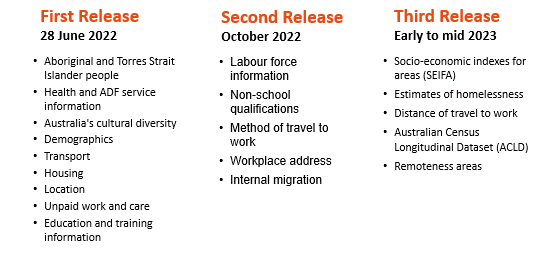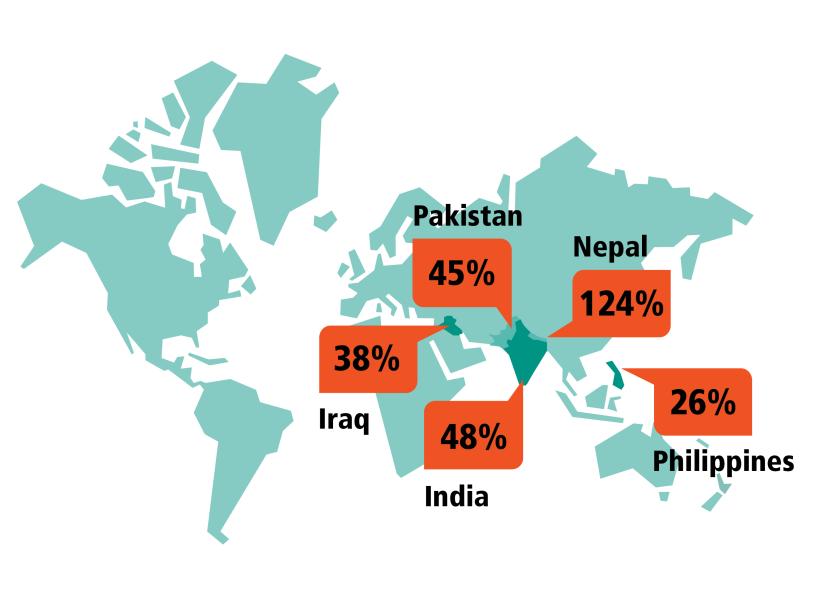Story 14: The 2021 Census data
Phased release of 2021 Census data
2021 Census data was published on 28 June 2022 as part of a three-phased approach to releasing the data. The first release included key demographic data about the population – age, sex, location of where people were in the country on Census day and where people usually live.
The first release of 2021 Census data also included information about cultural diversity, religious affiliation, Australian families and households.
For the first time, data was released from two new questions about long-term health conditions and service in the Australian Defence Force.
The phased release will continue with two further releases scheduled:
- 12 October 2022 – topics including employment, educational qualifications, and internal migration
- early to mid-2023 – more complex data such as distance to work, socio-economic indexes for areas and counts for people experiencing homelessness.
Image

Description
Stories emerging from the data
The first release of the Census data on 28 June 2022 showed we are a fast changing, growing and culturally diverse nation. The data provided a picture of the economic, social and cultural make-up of Australia. Australia’s population had grown to 25.4 million people, excluding overseas visitors. This was an increase of over two million people or 8.6% since the 2016 Census. Australia’s Census count had more than doubled in the last 50 years, with the 1971 Census counting over 12.5 million people.
The data showed almost 80% of Australian residents lived in eastern Australia in New South Wales, Victoria, Queensland and the Australian Capital Territory. Two thirds of people counted, 66.9%, were in Greater Capital Cities and 33.1% were in the rest of Australia. As with previous censuses, greater Sydney continued to be the largest city in Australia with 5.2 million people, followed by Melbourne with 4.9 million people and Brisbane with 2.5 million people.
Living with COVID-19
On Census day, Tuesday 10 August 2021, many parts of Australia were in lockdown or subject to border restrictions. The data has been reviewed with consideration of COVID-19 impacts. International border restrictions were in place and the 2021 Census counted 61,860 overseas visitors, significantly lower than 315,531 in 2016. We have seen that lockdown and travel restrictions influenced where people completed the Census:
- the Census household response rate increased from 95.1% in 2016 to 96.1% in 2021
- the percentage of households completing online was almost 80% in 2021, an increase from 63% in 2016
- two million more people were at home on Census night than in 2016.
Age and sex
The median age of all Australians remained at 38 years in 2021. Males made up 49.3% of the population with a median age of 37 years and females made up 50.7% with a median age of 39 years.
Australia has undergone a significant generational shift. Baby Boomers and Millennials each have over 5.4 million people, with only 5,662 more Baby Boomers than Millennials counted on 10 August 2021.
Aboriginal and Torres Strait Islander communities
The Census found that 812,728 people identified as Aboriginal and/or Torres Strait Islander. This has been an increase of over 25% (25.2%) since 2016, with Aboriginal and Torres Strait Islander people representing 3.2% of the Australian population. Of the Aboriginal and Torres Strait Islander people counted, 91.4% identified as Aboriginal, 4.2% as Torres Strait Islander, and 4.4% identified as both.
Culturally and linguistically diverse communities
Australia has a rich mix of cultural backgrounds and heritage, with the number of people living in Australia who were born overseas continuing to increase.
The proportion of Australian residents born overseas (first generation) or have a parent born overseas (second generation) has moved above 50% (51.5%).
The top five most commonly reported ancestries in the 2021 Census followed previous trends and included English at 33.0%, Australian at 29.9%, Irish at 9.5%, Scottish at 8.6% and Chinese at 5.5%.
Australia has continued to be a culturally and linguistically diverse country with the growth of communities from Nepal, India, Pakistan, Iraq and the Philippines.
Image

Description
Religious affiliation
The diversity of religious affiliation has increased across the Australian population.
The percentage of Australians reporting no religious affiliation has continued to grow and was recorded at 38.9% of the population, compared to 30.1% in the 2016 Census.
Christianity has remained the most common religion with 43.9% of the population identifying as Christian, a decrease from 52.1% in the 2016 Census.
- Comprises Buddhism, Hinduism, Islam, Judaism and Other Religions.
- Secular Beliefs and Other Spiritual Beliefs and No Religious Affiliation.
- Source: Religious affiliation (RELP).
Our families and households
The 2021 Census counted more than 10.8 million private dwellings across Australia. These dwellings were comprised of separate houses (70%), apartments (16%) and town houses (13%). The proportion of apartments has continued to increase, with apartments accounting for nearly one third (30.9%) of the increase in private dwellings since 2016.
The average number of people per household decreased from 2.6 in 2016 to 2.5 in 2021. The Census reflected that Australian families come in many shapes and forms. The 2021 Census counted 5.5 million (5,552,973) couple families, of which 53% had children living with them. Over one million one parent families were counted, of which four out of every five of those parents were female.
Service in the Australian Defence Force
More than half a million Australians (581,139) have served, or are currently serving, in the Australian Defence Force. One in twenty (5.3%) Australian households (dwellings) had at least one person who had served or is serving in the Australian Defence Force.
Health of the population
For the first time, the Census collected information on ten common long-term health conditions in Australia. Over eight million people reported they had been diagnosed with a long-term health condition in the 2021 Census.
- 4.8 million people reported having one of the selected long-term health conditions
- 1.5 million had two of the selected long-term health conditions
- 750,000 people reported having been diagnosed with three or more of the selected long-term health conditions.
Communication material
As part of the phased approach to releasing 2021 Census data, the ABS is publishing a suite of communication products and data tools to help people access the data. These will continue to be published into 2023 to support the second and third releases of the data. The communication products include national media releases, topic‑based articles delving deeper into the data insights and media backgrounders providing contextual information for journalists.
Data tools
Census data tools have been published on the ABS website to help people access the data in easy to use formats. Census tools include:
- Search for Census data providing geographic based data from QuickStats (75,000 areas) and Community Profiles (15,000 regions).
- Census topics providing access to stories and visualisations that relate to Census data on topics of interest e.g., population, health, families.
- DataPacks containing comprehensive data about people, families and dwellings for all Census geographies ranging from Australia down to Statistical Area Level 1.
- GeoPackages containing bulk data for multiple areas in geospatially enabled files.
2021 Census data is also available through additional tools that incorporate other ABS data. These include ABS Data APIs and DataLab.
The ABS plans to release further products including 2021 Census data in TableBuilder and a range of microdata products.
2021 Census data release launch
The 2021 Census data release launch took place on 28 June at 10:00am AEST in the National Portrait Gallery, Canberra. 2021 Census data was published at the same time on the ABS website. The event was live streamed and available to view from the ABS website. More than 9,000 people tuned into the live stream link from the ABS website, including the ABC News 24 channel which also streamed the event live on national television.
The data release launch officially began with a Welcome to Country delivered by Ngunnawal man, Wally Bell. The Hon Dr Andrew Leigh MP, Assistant Minister for Competition, Charities and Treasury, delivered opening remarks at the launch. This was followed by an address from Professor Sandra Harding AO, Emeritus Professor, James Cook University, Chair of the 2021 Census Statistical Independent Assurance Panel who acknowledged the 2021 Census data was fit-for-purpose, of comparable quality to previous censuses and could be used with confidence.
Dr David Gruen AO, Australian Statistician, and Ms Teresa Dickinson PSM, Deputy Statistician and Senior Responsible Officer for the 2021 Census, provided an overview of 2021 Census data insights across the topics released.
The presentations were followed by a 30-minute question and answer session with the audience, both live and virtually. The launch was attended by media from the Australian Parliament House Press Gallery, including SBS News, Sydney Morning Herald, Australian Financial Review, ABC News, The Australian, Canberra Times, Australian Associated Press and the Ten Network.
A live audience of 50 people included Commonwealth, state and territory government stakeholders and ABS staff. Following the formal proceedings, Census spokespeople participated in media interviews to facilitate television coverage of the data release.
A recording of the launch is available on the Events page of the ABS website.
Data release media coverage
The ABS delivered a strategic approach to media engagement for Census data release by publishing a suite of 10 media releases with Australia level 2021 Census data insights on the ABS website on Monday 27 June at midnight prior to the official data release launch on Tuesday 28 June. This resulted in significant national media coverage trending positive in sentiment across various media platforms.
Almost 14,000 news clips about 2021 Census data were published across radio, television, print and online with a 78.2 million potential total audience reach between Tuesday 28 June to Monday 4 July. Census spokespeople conducted 18 media interviews during this period, highlighting the stories emerging from the data at the national and state level.
On social media, ‘Census’ was the top trending topic on Twitter on 28 June at 6:00pm AEST. Audience reach on the 2021 Census Facebook page peaked at over 3.6 million during this period. We would like to thank the journalists and media outlets that help us tell the stories from the 2021 Census.
2021 Census data seminar series
The 2021 Census data seminar series commenced in July 2022 to share key data insights with stakeholders. The national data seminar took place on 7 July at Hotel Realm in Canberra and was live streamed for virtual attendees. The seminar included information on what the data tells us about how Australia has changed across the first release topics, uses of Census data and what Census data tools are available.
Data experts from the ABS presented an overview and this was followed by an audience question and answer session. The 2021 Census national data seminar is now available to watch on the ABS YouTube channel. This event was followed by an Aboriginal and Torres Strait Islander seminar on Monday 11 July, which is also available to watch online.
To facilitate understanding and engagement with the data, the ABS is hosting a Census data seminar for each state and territory to share insights at the regional level. Recordings of each seminar are available on the ABS website. The seminar series will continue before and after the second release of 2021 Census data. Later this year, the ABS is planning to host a series of topic-based seminars, including on multiculturalism in Australia, long-term health conditions and service in the Australian Defence Force.